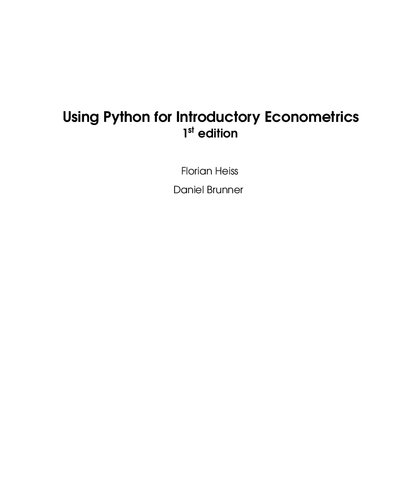(Ebook) Using Python for Introductory Econometrics by Florian Heiss, Daniel Brunner
Introduces the popular, powerful and free programming language and software package Python.Python is an ideal candidate for starting to learn econometrics and data analysis. It has a huge user base, especially in the fields of data science, machine learning, and artificial intelligence, where it arguably is the most popular software overall. These are very exciting areas and there is a lot of cutting edge research in the integration of their tools into the econometrics toolbox. So why not kill two birds with one stone and master a powerful and important software package while learning econometrics at the same time? Because Python must be hard to learn and to apply to econometrics? It is not at all, as this book shows.And Python is completely free and available for all relevant operating systems. When using it in econometrics courses, students can easily download a copy to their own computers and use it at home (or their favorite cafés) to replicate examples and work on take-home assignments. This hands-on experience is essential for the understanding of the econometric models and methods. It also prepares students to conduct their own empirical analyses for their theses, research projects, and professional work.A problem we encountered when teaching introductory econometrics classes is that the textbooks that also introduce Python do not discuss econometrics. Conversely, our favorite introductory econometrics textbooks do not cover Python. Although it is possible to combine a good econometrics textbook with an unrelated introduction to Python, this creates substantial hurdles because the topics and order of presentation are different, and the terminology and notation are inconsistent.Focus: implementation of standard tools and methods used in econometricsCompatible with "Introductory Econometrics" by Jeffrey M. Wooldridge in terms of topics, organization, terminology and notationCompanion website with full text, all code for download and other goodiesTopicsA gentle introduction to PythonSimple and multiple regression in matrix form and using black box routinesInference in small samples and asymptoticsMonte Carlo simulationsHeteroscedasticityTime series regressionPooled cross-sections and panel dataInstrumental variables and two-stage least squaresSimultaneous equation modelsLimited dependent variables: binary, count data, censoring, truncation, and sample selectionFormatted reports using Jupyter NotebooksThe book is designed mainly for students of introductory econometrics who ideally use Wooldridge as their main textbook. It can also be useful for readers who are familiar with econometrics and possibly other software packages. For them, it offers an introduction to Python and can be used to look up the implementation of standard econometric methods.
*Free conversion of into popular formats such as PDF, DOCX, DOC, AZW, EPUB, and MOBI after payment.


